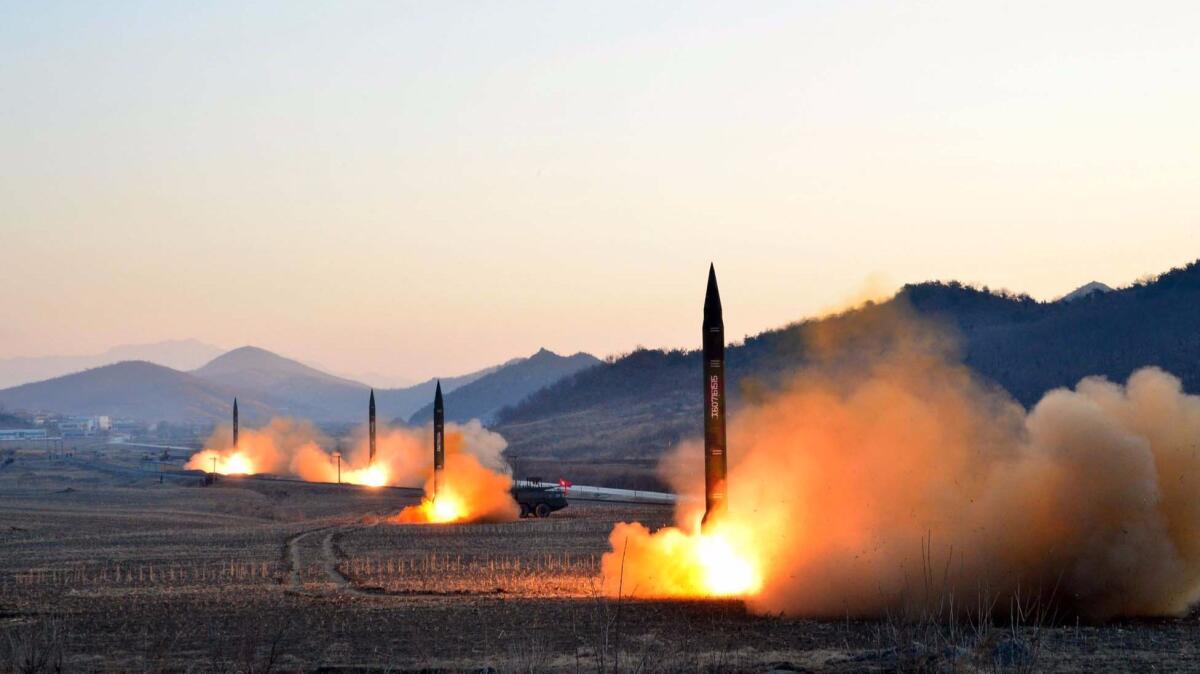North Korea amps up worries about potential threat to the U.S. power grid

The scenario is apocalyptic: The United States plunges into darkness after its electrical grid goes down — not just for a few hours or even a few days, but a vulnerable power system could take 18 months to recover, so long a period of time that millions would die.
The reason? An electromagnetic pulse, or EMP, attack from a terrorist group or rogue state using a nuclear weapon detonated in the atmosphere.
It sounds like something out of the most dystopian of Hollywood disaster movies.
But news that North Korea recently launched four missiles that traveled 620 miles before landing in the Sea of Japan has heightened concerns among those who have warned that an EMP attack that could essentially vaporize the U.S. energy infrastructure.
“I think this is the principal, the most important and dangerous, threat to the United States,” said James Woolsey, who served as chief of the CIA from 1993 to 1995.
“If you look at the electric grid and what it’s susceptible to, we would be moving into a world with no food delivery, no water purification, no banking, no telecommunications, no medicine. All of these things depend on electricity in one way or another,” Woolsey said.
Others say the grid needs to be bolstered but are not as fearful of a potential doomsday.
“I’m not on knife’s edge,” said Rob Manning, vice president of transmission for the research sector of the Electric Power Research Institute, or EPRI.
“EMP is a real threat, as is any number of of things that we deal with on a daily basis,” Manning said. “So all we can do is try to understand those threats greater and create ways to mitigate them or recover from them effectively.”
What exactly is an EMP?
A short burst of electromagnetic energy, an EMP can occur in nature. But with the dawn of the Atomic Age, U.S. and Soviet military officials and scientists soon learned EMPs can also be created when they tested nuclear weapons in the atmosphere.
In 1962, at the height of the Cold War, the U.S. military exploded a nuclear weapon high above an atoll in the Pacific that unexpectedly resulted in an EMP that blew out street lights and knocked out telephones in Hawaii, some 900 miles away.
The abrupt surge of energy is not believed to harm humans physiologically, but the pulse could create massive currents that would blow through power lines, destroying electrical transformers and damaging power plants.
EMPs from outside sources have been popularized in films such as “The Matrix” and the 1995 James Bond movie “GoldenEye,” but nature can deliver them too.
In 1859, a powerful geomagnetic storm known as the Carrington event produced auroras around the world and caused telegraph systems in North America and Europe to fail.
Today the anxiety comes from the idea of an enemy initiating a high-altitude EMP by attaching a nuclear weapon to a satellite, then detonating it as the satellite passes over the center of the U.S., inflicting the most possible damage.
North Korea already has two satellites that fly over the U.S. on a south-to-north trajectory.
“One of the myths out there is that you need a high-yield weapon to do an EMP attack,” said Peter Vincent Pry, chief of staff of the congressional EMP Commission who also served in the CIA. “Even a low-yield, primitive weapon like the bomb used in Hiroshima will produce a potentially catastrophic EMP field because it’s simply attacking things that are not hardened.”
The EMP Commission was appointed by Congress to assess the threat, and in 2004 and 2008 it issued reports urging a national commitment to protect everything from mobile devices to the overall power system from a potential EMP meltdown.
In its 2008 report, the EMP Commission estimated that within 12 months of a nationwide blackout, up to 90% of the population could die from starvation, disease and an overall breakdown of society.
Last month, EPRI released the first in a series of reports from a study looking at the potential effects of a single high-altitude electromagnetic pulse. The study concentrated on the fleet of 37,000 bulk power transformers in the continental U.S.
Such large transformers, commonly seen in substations, are greater than 69,000 volts and convert electricity from high-voltage electricity to levels that are distributed around neighborhoods.
“We found that there would likely be some failures, but those failures are relatively small in nature and not in the hundreds as had been contemplated from some of the reports in the past,” EPRI’s Manning said.
Manning added that “while I think this is good news,” at least four more reports will follow before the entire study is scheduled to wrap up in April 2019.
The EPRI research is funded by 50 utilities across the country, including Southern California Edison and Pacific Gas & Electric.
The EMP Commission’s Pry blasted the study, alleging that EPRI is compromised by having the study bankrolled by utility companies that he says have dragged their feet on bolstering the grid.
“It’s what I call the junk science EPRI study, and you can quote me on that,” Pry said.
EPRI officials insist that their study is unbiased.
“We are a fiercely independent organization,” Manning said. “That’s been our history over the last 40 years, and that’s very much our mantra.”
The EMP Commission estimated nine years ago that it would cost about $2 billion to protect the electric grid.
“I think that would be a bare beginning,” said Woolsey, the coauthor of a number of opinion pieces with Pry. “Most of the estimates I hear from people [to strengthen] the grid and the web as a whole is in the tens of billions.”
rob.nikolewski@sduniontribune.com






